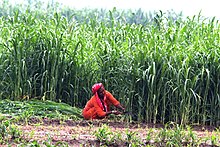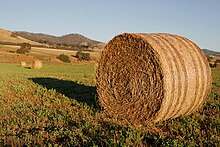Fodder

Fodder (/ ˈfɒdər/), nke a na-akpọkwa provender (/ ˈprɒvəndər/), bụ nri ugbo ọ bụla a na-eji achịkọta anụ ụlọ, dị ka ehi, oke bekee, atụrụ, ịnyịnya, ọkụkọ na ezi. "Fodder" na-ezo aka karịsịa nri a na-enye ụmụ anụmanụ (gụnyere osisi ndị a kpụrụ akpụ na-ebuga ha), karịa nke ha na-eri maka onwe ha (nke a na-akpọ nri nri). Nri nri na-agụnye ahihia, ahịhịa, silage, nri mpịakọta na pelleted, mmanụ na nri agwakọta, na ọka na mkpo ọka (dị ka agwa pulitere, malt ọhụrụ, ma ọ bụ mebere malt). Ọtụtụ nri anụmanụ sitere na osisi, mana ụfọdụ ndị na-emepụta ihe na-agbakwunye ihe oriri na nri ndị a haziri nke sitere na anụmanụ.
The worldwide animal feed trade produced 1.245 billion tons of compound feed in 2022 according to an estimate by the International Feed Industry Federation,[1] with an annual growth rate of about 2%. The use of agricultural land to grow feed rather than human food can be controversial (see food vs. feed); some types of feed, such as corn (maize), can also serve as human food; those that cannot, such as grassland grass, may be grown on land that can be used for crops consumed by humans. In many cases the production of grass for cattle fodder is a valuable intercrop between crops for human consumption, because it builds the organic matter in the soil.[Tinye edensibịa][citation needed] When evaluating if this soil organic matter increase mitigates climate change, both permanency of the added organic matter as well as emissions produced during use of the fodder product have to be taken into account.Templeeti:Clarify[<span title="The text near this tag may need clarification or removal of jargon. (July 2021)">clarification needed</span>] Some agricultural byproducts fed to animals may be considered unsavory by humans.[Tinye edensibịa]

Osisi ndị a na-ahụkarị a na-akụ maka nri
[dezie | dezie ebe o si]


- Alfalfa (lucerne)
- Barley
- Akpụkpọ anụ a na-ahụkarị[2]
- Ụkwụ nnụnụ
- Brassica spp.
- Kale
- Rapeseed (canola)
- Rutabaga (Swedish)
- Turnip
- Clover
- Ihe osise Alsike
- Clover na-acha ọbara ọbara
- Clover dị n'okpuru ala
- Clover ọcha
- Ahịhịa
- Ahịhịa Bermuda
- Ịkpa ọchị
- Ahịhịa oat adịgboroja
- Fescue
- Ahịhịa ahịhịa
- Ahịhịa ahịhịa (site na ahịhịhịa agwakọta)
- Ahịhịa mkpụrụ osisi
- Ryegrass
- Ahịhịa Timoti
- Mkpụrụ ọka
- Millet
- Oats
- Sorghum
- Soya
- Osisi (osisi Pollard maka "osisi-hay")
- Ọka wit


Ụdị
[dezie | dezie ebe o si]- Biochar maka ehi[3]
- Bran
- Osisi ndị a na-echekwa maka nri: hay na silage
- Nri na ihe ndị e ji eme ihe, nke a na-akpọkarị pellets, mkpụrụ osisi ma ọ bụ (ụmụ ehi) achịcha
- Ihe ọkụkụ fọdụrụnụ: stover, copra, ahịhịa, chaff, shuga beet waste
- Nri azụ̀
- ahịhịa a ka gbuturu ọhụrụ na ahịhịa ndị ọzọ
- Ahịhịa ma ọ bụ ahịhịa na-egbutu ahịhịhịa [4]
- Mkpụrụ ọka na-acha akwụkwọ ndụ akwụkwọ ndụ
- sorghum na-acha akwụkwọ ndụ akwụkwọ ndụ
- Gram ịnyịnya
- Akwụkwọ osisi ụfọdụ[5]
- Nri anụ na ọkpụkpụ (nke iwu na-akwadoghị ugbu a na nri ehi na atụrụ n'ọtụtụ ebe n'ihi ihe ize ndụ nke BSE)
- Mkpụrụ osisi molasses
- Ahịhịa na-acha akwụkwọ ndụ akwụkwọ ndụ
- Mkpụrụ mmanụ (cottose, safflower, sunflower, soybean, ahụekere ma ọ bụ groundnut)
- Oligosaccharides
- Ụmụ ahụhụ a na-edozi edozi (ya bụ, igurube a na-edezi edozi )
- Seaweed (gụnyere Asparagopsis taxiformis nke a na-ejikarị eme ihe dị ka mgbakwunye iji belata ikuku methane ruo 90%)
- Mkpụrụ na ọka, ma ọ bụ zuru ezu ma ọ bụ kwadebere site na ịpịsị, ịpị, wdg.
- Single cell protein (a pụkwara iji CO2 ikuku mee ya) [6]
- Mkpụrụ osisi na legumes a kụrụ akụ
- Ihe na-eme ka ọ bụrụ ihe na-eme ya
Nchegbu ahụike
[dezie | dezie ebe o si]N'oge gara aga, bovine spongiform encephalopathy (BSE, ma ọ bụ "ọrịa ehi na-agba ara") gbasara site na ntinye anụ aru na nri ọkpụkpụ na nri ehi n'ihi mmetọ prion. Ugbu a amachibidoro omume a n'ọtụtụ mba ebe o mere. Ụfọdụ anụmanụ nwere ntachi obi dị ala maka nri nri emebi emebi ma ọ bụ nke ebu karịa ndị ọzọ, na ụfọdụ ụdị ebu, nsị, ma ọ bụ ahịhịa na-egbu egbu na-agwakọtaghị ya na ebe nri nwere ike ịkpata mfu akụ na ụba n'ihi ọrịa ma ọ bụ ọnwụ nke anụmanụ. Ngalaba na-ahụ maka ahụike na ọrụ mmadụ na United States na-ahazi ọgwụ ndị dị n'ụdị ntụziaka nri anụmanụ nke nwere ike ịdị na nri anụ ụlọ azụmahịa.[Tinye edensibịa]
Oké ọkọchị
[dezie | dezie ebe o si]

Ịbawanye ike na ugboro ole ụkọ mmiri ozuzo na-eme ka ọrụ ugbo nọrọ n'okpuru nrụgide n'ebe ndị kpọrọ nkụ na ebe ndị kpọrọ nká. A kọọrọ echiche ọhụrụ nke mmepụta nri anụ ụlọ mberede, dị ka mmepụta nri ehi sitere na ọhịa na Namibia. N'oge ọkọchị dị ogologo, ụfọdụ ndị ọrụ ugbo ejirila eriri osisi sitere na osisi dị ka isi ihe na-enye ha nri ehi, na-agbakwunye ihe ndị na-edozi ahụ na mpaghara yana imeziwanye ụtọ. [7][8][9]
Mmepụta nke mkpụrụ osisi ndị e gbuturu dị ka nri
[dezie | dezie ebe o si]
Fodder n'ụdị mkpụrụ ọka na-eto eto dị ka ọka bali, na legumes nwere ike ịzụlite na obere na nnukwu.
Systems have been developed recentlyTempleeti:When that allow for many tons of sprouts to be produced each day, year round. Sprouted grains can significantly increase the nutritional value of the grain compared with feeding the ungerminated grain to stock.[10] In addition, they use less water than traditional forage, making them ideal for drought conditions. Sprouted barley and other cereal grains can be grown hydroponically in a carefully-controlled environment.[11] Hydroponically-grown sprouted fodder at 150 mm tall with a 50 mm root mat is at its peak for animal feed.
Ọ bụ ezie na ngwaahịa ndị dị ka ọka bali bụ ọka, mgbe ha gburu, American Grassfed Association kwadoro ha ka ha jiri ya mee ihe dị ka nri anụ ụlọ. [citation needed]
Hụkwa
[dezie | dezie ebe o si]
- Cannon fodder (iji ya eme ihe n'ụzọ ihe atụ)
- Ọrụ ugbo gburugburu
- Ọrụ ugbo n'ụlọ ọrụ
- Nhazi nri
- Usoro nri
- Ebe ịta ahịhịa
Ebem si dee
[dezie | dezie ebe o si]- ↑ Global Feed Statistics. International Feed Industry Federation. Retrieved on 18 March 2024.
- ↑ Devlamynck (May 2018). Valorization of agricultural wastewater streams into an alternative protein source duckweed.
- ↑ Daly (18 October 2019). Poo-eating beetles and charcoal used by WA farmer to combat climate change. ABC.net.au. Australian Broadcasting Corporation. “Mr Pow said his innovative farming system could help livestock producers become more profitable while helping to address the impact of climate change.”
- ↑ Logsdon (2004). All Flesh Is Grass. Ohio University: Swallow Press. ISBN 0-8040-1069-2.
- ↑ Fodder trees for more milk and income. Department for International Development. Archived from the original on 2015-09-27. Retrieved on 2015-09-22.
- ↑ Giec (1988). "Single cell protein as food and feed". Nahrung 32 (3): 219–29. DOI:10.1002/food.19880320302. PMID 3292921.
- ↑ Report on the Bush-to-Feed Pilot Projet in the African Wild Dog Community Forest. Ministry of Agriculture, Water and Forestry (2018). Archived from the original on 2021-02-25. Retrieved on 2024-07-23.
- ↑ Matthys. "Manual on how to produce animal feed from local encroached bush launched", Namibia Economist, 2018-11-30.
- ↑ "Turning bush to feed in face of drought", The Namibian, 2016-10-18. Retrieved on 2020-06-22.
- ↑ Sneath (October 2003). Review of Hydroponic Fodder Production for Beef Cattle. Meat & Livestock Australia Limited. ISBN 1740365038. Retrieved on 7 June 2018.
- ↑ Sneath (October 2003). Review of Hydroponic Fodder Production for Beef Cattle. Meat & Livestock Australia Limited. ISBN 1740365038. Retrieved on 7 June 2018. “Hydroponic sprouts may have profitable application in intensive, small-scale livestock situations with high value outputs, where land and alternative feed costs are high, and where the quality changes (eg less starch, more lysine, vitamins, etc) due to sprouting are advantageous to the particular livestock.”
